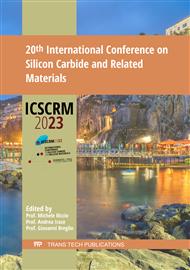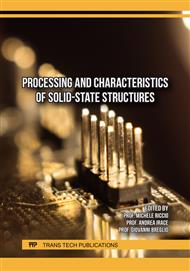[1]
Stefanakis, D. et.al. (2014). TCAD models of the temperature and doping dependence of the bandgap and low field carrier mobility in 4H-SiC. Microelectronic Engineering, 116, 65-71.
DOI: 10.1016/j.mee.2013.10.002
Google Scholar
[2]
Ivanov, I. V., and Kozlov, A. G. (2019). Hole mobility model for 6H-SiC thermo-resistive sensors simulation. In 2019 International Siberian Conference on Control and Communications (pp.1-5). IEEE.
DOI: 10.1109/sibcon.2019.8729619
Google Scholar
[3]
Caughey, D. M., and R. E. Thomas. "Carrier mobilities in silicon empirically related to doping and field," Proceedings of the IEEE, Vol. 55, (1967): 2192–2193.
DOI: 10.1109/proc.1967.6123
Google Scholar
[4]
Arora, N. D., J. R. Hauser, and D. J. Roulston, "Electron and hole mobilities in silicon as a function of concentration and temperature," IEEE Transactions on Electron Devices, Vol. 29 (1982): 292–295.
DOI: 10.1109/t-ed.1982.20698
Google Scholar
[5]
SILVACO TCAD Software : https://silvaco.com/tcad
DOI: 10.1142/9789813237834_0003
Google Scholar
[6]
Uhnevionak, Viktoryia, et al. "Comprehensive study of the electron scattering mechanisms in 4H-SiC MOSFETs." IEEE Transactions on Electron Devices 62.8 (2015): 2562-2570.
DOI: 10.1109/ted.2015.2447216
Google Scholar
[7]
Dixit, Hemant, et al. "Temperature Dependent Mobility Model for Predictive TCAD Simulations of 4H-SiC." Materials Science Forum. Vol. 1090. Trans Tech Publications Ltd, 2023.
DOI: 10.4028/p-1my2o8
Google Scholar
[8]
Klaassen, D. B. M. (1992). A unified mobility model for device simulation—I. Model equations and concentration dependence. Solid-State Electronics, 35(7), 953-959.
DOI: 10.1016/0038-1101(92)90325-7
Google Scholar
[9]
Klaassen, D. B. M. (1992). A unified mobility model for device simulation—II. Temperature dependence of carrier mobility and lifetime. Solid-State Electronics, 35(7), 961-967.
DOI: 10.1016/0038-1101(92)90326-8
Google Scholar
[10]
Lombardi, Claudio, et al. "A physically based mobility model for numerical simulation of nonplanar devices." IEEE Transactions on Computer-Aided Design of Integrated Circuits and Systems 7.11 (1988): 1164-1171.
DOI: 10.1109/43.9186
Google Scholar
[11]
Darmody, C., and N. Goldsman. "The intrinsic atomic-level surface roughness mobility limit of 4H-SiC." Journal of Applied Physics 124.10 (2018).
DOI: 10.1063/1.5042765
Google Scholar
[12]
Das, Suman, et al. "Study of carrier mobilities in 4H-SiC MOSFETS using Hall analysis." Materials 15.19 (2022): 6736.
DOI: 10.3390/ma15196736
Google Scholar
[13]
Noguchi, M., et al. "Determination of intrinsic phonon-limited mobility and carrier transport property extraction of 4H-SiC MOSFETs." 2017 IEEE International Electron Devices Meeting (IEDM). IEEE, 2017.
DOI: 10.1109/iedm.2017.8268358
Google Scholar



